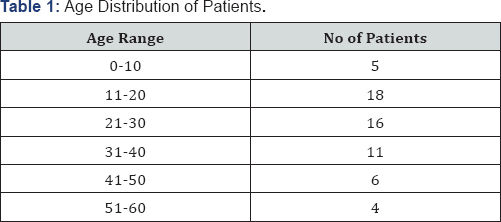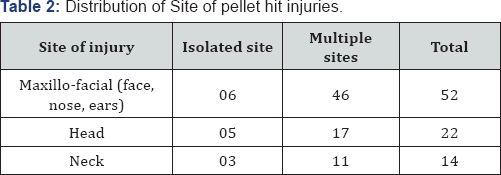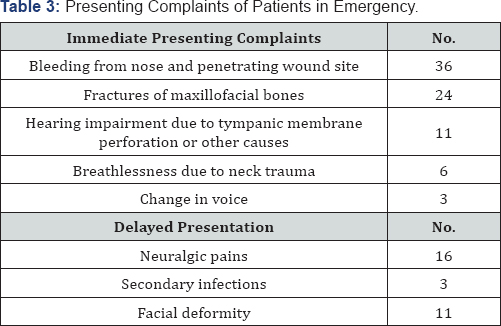Pellet Gunfire Injuries in Head- Neck and MaxilloFacial Region- an Experience in Kashmir Valley
Showkat Ahmad Showkat, Aamir Yousuf* and Ifthkhar Ali
Department of Maxillo-Facial Region, India
Submission: December 13, 2016; Published: March 22, 2017
*Corresponding author: Aamir Yousuf, Department of Maxillo-Facial Region, India, Email: miraamir_83@yahoo.com
How to cite this article: Showkat A S, Aamir Y, Ifthkhar A. Pellet Gunfire Injuries in Head- Neck and Maxillo-Facial Region- an Experience in Kashmir Valley. Glob J Oto 2017; 5(4): 555669. DOI: 10.19080/GJO.2017.05.555669
Abstract
Pellet gun injuries is quite commonly faced emergency nowadays in Kashmir because of recent turmoil in valley and has invited a different challenges in modern day to day practice of surgeons mostly otolaryngologists and ophthalmologists. For this reason a study was conducted in an only tertiary care otolaryngology head and neck referral centre, ENT SMHS Srinagar between July 2016 to September 2016. The pattern , severity and outcome of injuries in head and neck and maxilla-facial region among pellets gun victims in Kashmir region was studied and their management was categorized based on demand and need.
Keywords: Kashmir; Pellet gun
Introduction
Airguns have been considered potentially lethal weapons since historical times. They are capable of causing life threatening injuries. Ktesbias II of Egypt first used compressed air to propel a projectile around 250 BC [1]. Airguns were known as wind chambers, and used an air reservoir connected to a cannon barrel was used. These weapons were used in the Napoleonic wars in the late 17th and early 18th centuries [1]. The modern high-powered rifles can propel a pellet beyond 1100 ft/s (330 m/s), approximately the speed of sound, and produce a noise similar to a 22-calibre rim fire rifle [1,2]. They can generate muzzle velocities of 350 ft/s or more. Pellet guns - a form of shotgun - were first used by the police as a non-lethal weapon to quell protests in Indian-administered Kashmir in 2010. They are usually used for hunting animals. The gun fires a cluster of small, round-shaped pellets, which resemble iron balls, with high velocity.
The typical projectile used in rifled airguns is the lead diabolo pellet but in Kashmir iron pellets were used [2]. These relatively low-energy missiles produce direct effects on tissues such as laceration and crushing within the missile tract as was also seen in our cases. A majority of these injuries has occurred in children and young adolescents. The risks involved with these injuries increases because it is mostly the head and neck region that was seen affected. There are vital neurovascular bundles, major vessels, trachea, esophagus, and spinal cord in this region that prompts for an early diagnosis and immediate management.
Materials and Methods
All the patients who came directly as primary head and neck / maxillofacial injury by pellets or were referred to ENT emergency due to multiple injuries including head and neck/ maxillofacial region between July 2016 to September 2016(100 DAYs) were registered for study. All the patients with severe injuries with vital organ involvement who needed life saving interventions were excluded from study. The study was conducted in the department of Otolaryngology dept SMHS Srinagar. In all cases primary management was done in emergency. After proper evaluation and investigations the patients were shifted to the ward or emergency operation theater as necessary.
Radiographic image was advised in all and in cases were neck was involved ultrasonography and in some computerized tomography was done. The pattern of injuries, position of the pellet in head and neck region were distributed as maxillofacial, head and neck isolated or combined injuries and was tabulated. The management was categorized as early intervention, late intervention and/or no intervention based on degree of injury and demand of symptom management and overall outcome of the patient was considered in the study (Table 1).

Results
Total of 60 patients were documented 48 males 12 females.The most common region involved being maxillofacial (52), head (22) & neck (14) (Table 2). The most common immediate presentation seen was bleeding from open wounds and epistaxis (36), facial bone fractures most commonly seen was nasal bone in 14, ethmoid bone in 3, maxillary and inferior orbital wall fractures in 7 patients because of direct impact of pellet shell, impaired hearing in 11, breathlessness in 6 due to direct laryngeal penetrating of pellet (Tables 3 & 4). In Late presentation group secondary infections was seen in 3 patients only, neuralgic pains in 16 mostly maxillofacial region and scalp region, disfigurement due to maxillofacial bony fractures and bad traumatic scars on face was seen in 11 patients (Figure 1).




Discussion
Over the past few years security forces in Kashmir valley have been using pump action shot gun or pellet gun to disperse mobs. To curb agitated mobs, the security forces fire pellet gun cartridges, considered to be a non-lethal weapon. A single pellet gun cartridge upon fire from pellet gun breaks into more than 500 small iron pellets which can penetrate any body tissue including eyes [2,3]. A body can thus receive one or multiple pellets and depending upon its velocity and distance from which fired can cause both penetrating and non-penetrating injury to the whole body with predominance including head-neck and maxillofacial region. Injuries in head-neck and maxillofacial region were seen with frightful deformity in the recent turmoil.
In the present study the pattern of pellet gun injures in head-neck and maxillofacial region have been elucidated with clinicoradilogical documentation of various facial bony fractures and localization of metallic pellets were done. The management categorization was based on type of emergency whether being mild, moderate or severe type. In the mild type like the patients with multiple penetrating injuries with pellets in maxillofacial region and head - neck region without involvement of vitals structures and without any acute presentation like bleeding breathlessness, change in voice, facial deformity, no intervention thus avoiding more tissue loss with exploration of deep wounds in search of pellets. As explained in table 4 majority of injuries about 42% of maxilo-facial injuries, 72% of pellets in head region and 78% of pellet injuries in neck region were kept as such without any intervention.
These patients were followed up for about 6 weeks for delayed complication. In 23% of pellet in maxillofacial region and 18% of pellets in head region had to be managed lately as non- resolving neuralgic pain based on patients demand or need and for secondary infections. According to these findings, it could be suggested that pellets can retain for long years without appreciable symptoms and signs, and may be left in situ without any surgical intervention. In the moderate and severe forms like the patients with open burst wounds (non penetrating injuries) presenting with bleeding profusely and fractures of maxillofacial bones and with other changes like bleeding, breathlessness, change in voice, facial deformity, early intervention was done. The proper homodynamic resuscitation, airway management followed by proper evaluation of primary and concomitant injuries with its management has later on improved the functional outcome of patients decreases the mortality and morbidity of pellet injuries in head-neck and maxillofacial region.
Holland et al. have reported three cases of penetrating airgun injuries to the neck [3]: two had the pellet removed and one was managed conservatively. David also published a case involving penetrating injury to the neck in a young adult who had the pellet removed from the posterior esophageal wall. An estimated 32,000 injuries attributable to non powder firearms (i.e., BB gun, pellet gun, and air rifle) occur each year in the United States, most of which are seen in the pediatric population [1,3]. Many case reports of serious and even fatal non-powder firearm injuries and /or shot gun injuries have been published describing ocular, intracranial, abdominal, and thoracic wounds [4,5] but there is no single data regarding the pattern, severity and outcome of pellet injuries inflicted while controlling agitated crowds in a defined population. In our study such issues have been highlighted and all the managements were done based on need and demand and were categorized based on time of intervention.
Conclusion
Maxillofacial and head-neck pellet injuries are increasing with unrest in valley now. As very less data is available in literature relating to such injuries, a collaborative cohort study needs to be done to study severity, pattern and long term outcome in such patients.
References
- Tarun Gurjar APM, Chandrakant AK (2015) Longstanding Multiple Pellets in Head and Neck Following Blast Injury. J Clin Case Reports 05(08): 1-2.
- Mushtaque M, Mir MF, Bhat M, Parray FQ, Khanday SA, et al. (2012) Pellet gunfire injuries among agitated mobs in Kashmir. Ulus Travma Acil Cerrahi Derg 18(3): 255-259.
- McNeill AM, Annest JL (1995) The ongoing hazard of BB and pellet gun- related injuries in the United States. Ann Emerg Med 26(2): 187-94.
- Wakode PT, Ghimire A, Acharya R (2008) Missile injuries in head- neck and maxillo-facial region -an experience in eastern nepal. Indian J Otolaryngology Head Neck Surg 60(2): 137-141.
- Rashid W, Shaheen N, Lone IA, Sajjad S (2014) Pellet Gun Fire Injuries in Kashmir Valley - Cause of Ocular Morbidity. J Evol Med Dent Sci 3(29): 8051-8058.





























